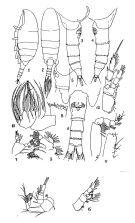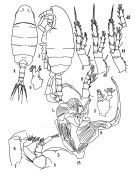|
|
 |
Fiche d'espèce de Copépode |
|
|
Calanoida ( Ordre ) |
|
|
|
Clausocalanoidea ( Superfamille ) |
|
|
|
Aetideidae ( Famille ) |
|
|
|
Senecella ( Genre ) |
|
|
| |
Senecella siberica Vyshkvartzeva, 1994 (F,M) | |
| | | | | | | Ref.: | | | Vyshvartzeva, 1994 (p.113, figs.F,M); Markhaseva, 1996 (p.297, figs.F,M); Boxshall & Halsey, 2004 (p.58) |  issued from : N.V. Vyshkvartzeva in Hydrobiologia, 1994, 292/293. [Fig.1: 1-11, p.114; Fig.2: 14-15, p.116]. Female: 1, habitus (left side); 2 idem (dorsal view); 3, Th5-6 and urosome (right side); 4, Th6 and urosome (left side); 5, genital segment (left side) (other specimen); 6, urosome (ventral view); 7, palp of mandible; 8, cutting edge of mandible; 9, Mx1; 10, Mx2; 11, Mxp.; 12, P4; 14, A2; 15, P1. Nota: Cephalothorax about 2.9-3.0 times longer than urosome. Rostrum absent. A1 24-segmented. Posterior corners of last thoracic segment rounded, reaching the anterior third of genital segment. Genital segment nearly as long as 3 following segments together, slightly asymmetrical (ventral view). Endopod of A2 slightly shorter than exopod; exopodal segments 1 and 2 with 2 setae each. Md: basis of palp with 2 setae; endopodal segments 1 with 2 setae, 2nd segment with 10 setae. Mx1 gnathobase with 9 terminal spines and 4 posterior setae; 2nd and 3rd internal lobes with 5 and 4 setae respectively; protopodite near endopodal basis with 5 setae; endopod with 16 setae; exopod with 10 setae. Mx2 with 6 endites, 6th endite with 2 setae. Mxp protopodite with 1 seta proximally and groups of 2, 3 and 3 setae from proximal to distal part of the segment. Segmentation of P1-P4 typical of Aetideidae. exopdal segment 1 of P1 without external spine; 2nd and 3rd segments with external spine each. Exopodal segment 3 of P3-P4 with 3 external spines each. Nota female from Markhaseva (1996, p.297): Genital segment slightly asymmetrical. Exopodal segment 3 of P2-P4 with 3 external spines.
|
 issued from : N.V. Vyshkvartzeva in Hydrobiologia, 1994, 292/293. [Fig.2: 1-13, p.116]• Male: 1, habitus (dorsal view); 2 idem (left side); 3, rostrum (ventral); 4, A2; 5, palp of mandible; 6, Mx1; 7, basipodite of Mxp.; 8, P1; 9, P2; 10, P3; 11, left P4; 12, right endopodite of P4; 13, P5 (R: right, L: left) Nota: Cephalothorax nearly 2.5-2.6 times longer than urosome. Rostrum present, very small, conical. A1 24-segmented, symmetrical, reaching the end of cephalothorax. Oral part with setation reduced in comparison with those in females. Mx1 and Mx2 are severely reduced. P1-P4 almost similar to the female. P5 is large and asymmetrical. Right leg with endopod long clapper-like, reaching slightly beyond of right exopodal segment 2; exopodal segment 1 subcylindrical, 2 times as long as wide; a narrow hyaline lamella rises at the inner distal angle of this segment and extends inwards along exopodal segment 2; exopodal segment 2 small, with small spine at its outer distal angle and long terminal hook, not separated from the segment. Left leg about trapezoidal with a narrow base and cup-like wide distal edge and with digitiform process at the outer distal angle, reacing far beyond exopodal segment 1. Exopodal segment 1 is oblong, 1.5 times as long as wide with convex outer edge; exopodal segment 2 larger than the 1st, distal margin hyaline, wavy with small spine in the inner distal angle and digitiform process near its base. Nota male from Markhaseva (1996, p.297): Endopod of left P5 with digitiform process significantly longer than exopodal segment 1.
| | | | | NZ: | 1 | | |
|
Carte de distribution de Senecella siberica par zones géographiques
|
| | | | Loc: | | | E Siberia E (Kara & Laptev Seas: Bays and estuaries).
Type locality: 71°46'N, 128°51'E. | | | | N: | 1 | | | | Lg.: | | | (267) F: 3,3-3; M: 2,88-2,8; {F: 3,00-3,30; M: 2,80-2,88} | | | | Rem.: | brackish.
Voir aussi les remarques en anglais | | | Dernière mise à jour : 01/02/2015 | |
|
|
 Toute utilisation de ce site pour une publication sera mentionnée avec la référence suivante : Toute utilisation de ce site pour une publication sera mentionnée avec la référence suivante :
Razouls C., Desreumaux N., Kouwenberg J. et de Bovée F., 2005-2025. - Biodiversité des Copépodes planctoniques marins (morphologie, répartition géographique et données biologiques). Sorbonne Université, CNRS. Disponible sur http://copepodes.obs-banyuls.fr [Accédé le 11 décembre 2025] © copyright 2005-2025 Sorbonne Université, CNRS
|
|
 |
 |





